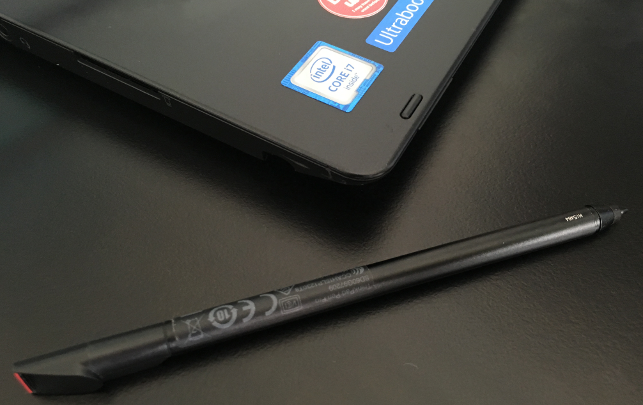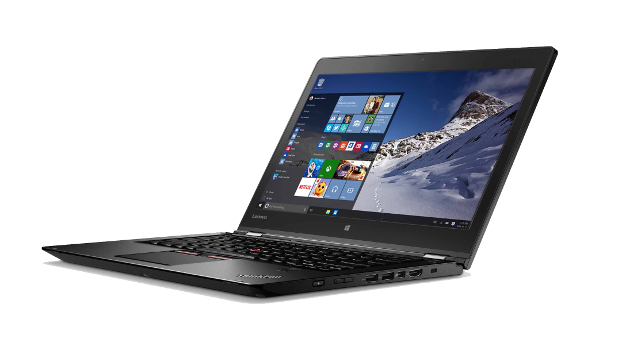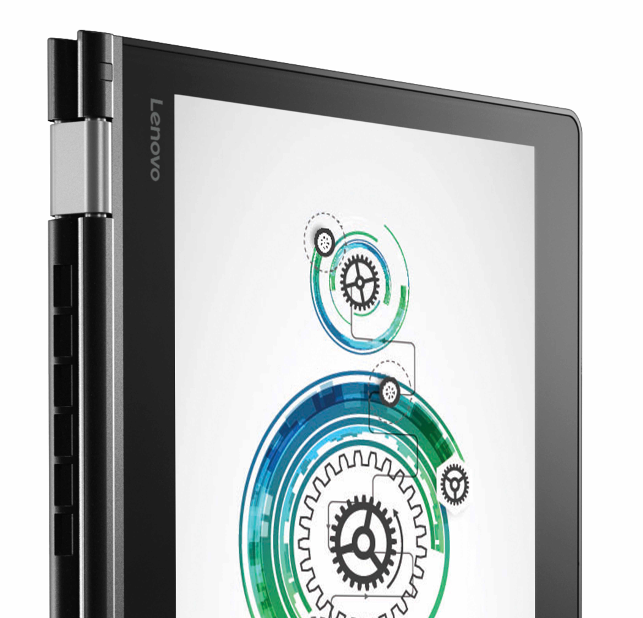ThinkPad P40 Yoga – Lenovo re-imagines the 14-inch mobile workstation with a lightweight multi-mode device that flips between laptop and tablet with ease
The 14-inch mobile workstation has never really taken off in the design sector. Over the past ten years, only Dell and HP have launched 14-inch machines and neither sold particularly well.

Laptop mode
With both manufacturers now focusing exclusively on 15-inch and 17-inch form factors, the timing is good for Lenovo to enter this historically difficult market sector. But, rather than simply shrinking down its larger ThinkPad mobile workstations, the company’s new ThinkPad P40 Yoga is a 14-inch with a twist — that twist being quite literal, in that the lightweight multi-mode laptop can be transformed into a pressure sensitive pen tablet in seconds.
It’s an exciting proposition for designers who want the freedom of a tablet and the power of a fully certified mobile CAD workstation in a single device.
The ThinkPad P40 Yoga is an evolution of Lenovo’s business class laptop, the ThinkPad Yoga 14. Thanks to a versatile 360-degree hinge, it can be used in a number of modes: standard ‘laptop’, ‘tablet’, as well as ‘stand’ and ‘tent’.
The idea is that product designers can pick up the integrated Wacom pen and start sketching, then move into 3D CAD without having to change devices.

Tent mode
This flexibility, while unique among mobile workstations, is not a new concept for product designers. Microsoft’s excellent Surface Pro 4, currently being championed by Siemens for running Solid Edge, can also handle both tasks.
The difference with the Lenovo ThinkPad P40 Yoga, however, is in its superior graphics performance.
While the Surface Pro relies on integrated Intel graphics (built into the CPU), the ThinkPad P40 Yoga has a discrete professional GPU from Nvidia.
The Nvidia Quadro M500M may lack the punch of a 15-inch mobile workstation GPU like the Quadro M2000M but we were quite surprised just how capable it is at working with complex assemblies.
ThinkPad P40 Yoga – yoga master
When you are used to having a separate laptop and tablet it takes a while to get your head round having both in a single device.
However, as it’s so easy to flip between the different modes it soon becomes quite natural to transform the ThinkPad P40 Yoga for different workflows.
To go from laptop to tablet simply bend the screen back on itself. The laptop keys automatically lift so they are flush with the surround, then lock into position to protect against accidental keystrokes.
The trackpad also automatically disables and Windows 10 changes the user interface accordingly.
The hinge on the ThinkPad P40 Yoga doubles as a grip, which is handy for stopping the device slipping out of your hand. Weighing in at 1.8kg and with a thickness of 19.9mm the ThinkPad P40 Yoga is considerably bulkier than dedicated tablets.
We found it most comfortable to use when sitting, resting the device on the lap.
ThinkPad P40 Yoga – touchy feely
For simple tasks like browsing websites, it is really intuitive to tap and swipe the multi touch panel with your fingers, but precision work is best left to a pen.
The slimline ThinkPad Pen Pro is powered by Wacom’s Active ES technology — the very same technology found in Wacom’s Intuos and Cintiq products. It offers 2,048 levels of pressure sensitivity, double that of the Microsoft Surface Pro 4.
In Wacom compatible applications like Autodesk SketchBook Pro, Made with Mischief or Photoshop pressing harder with the pen gives a thicker line or increases opacity.
Custom brushes can be created with different responses to light and heavy pen pressure. Tilting the pen can also give you different effects.
The included ThinkPad Pen Pro is incredibly slender, primarily so it can be docked inside the machine for storage and charging (Lenovo says a 30 second charge will give 8-hours of use thanks to a built-in super-capacitor).

Slimline ThinkPad Pen Pro, which docks in the side of the machine
This is super convenient, but there is a trade off in ergonomics. While we found the pen perfectly fine for general tablet use, it was a little too thin to sketch comfortably, particularly when using the integrated side buttons for ‘erase’ or to bring up radial menus in Autodesk SketchBook.
The good news is, for £30 you can get a chunkier pen, 9.5mm in diameter. We didn’t get to try this for size but have read good reports about its ergonomics. It is not rechargeable though, instead relying on an AAAA battery.
Both pens come with a durable POM plastic tip but there are optional felt tips for those who prefer a more natural sketching experience.
While Lenovo places a big focus on concept sketching, we also found the ThinkPad P40 Yoga to be great for marking up drawings and models in applications like Bluebeam Revu CAD.
Josh Mings from SolidSmack has even developed a custom workflow for running SolidWorks in tablet mode.
Indeed, the beauty of the P40 Yoga is that it more than capable of handling 3D CAD work and, despite its entry-level positioning, we were impressed with its performance.
ThinkPad P40 Yoga – workstation laptop
In laptop mode, the Yoga feels exactly like any mobile workstation.
Input is via Trackpad or TrackPoint but we prefer a Bluetooth mouse with 3Dconnexion SpaceNavigator for navigating 3D models. The touch screen can still be used as and when required.
With a thermal design power of 15W our test machine’s low voltage Intel Core i7-6500U CPU is very entry-level as far as mobile workstations are concerned.
However, it still clocks up a rather respectable 2.5GHz (Turbo to 3.1GHz), which is important for CAD work. For a bit more oomph, you can upgrade to an Intel Core i7- 6500U CPU 2.6GHz (Turbo to 3.4GHz).
With only two CPU cores, however, you probably won’t want to rely on it too much for multithreaded processes such as ray trace rendering. For comparison, the Intel Core i7-6500U took nearly 2.5 times as long to render our 3ds max scene as a quad core Intel Xeon E3-1505M v5 (a typical CPU for a 15-inch mobile workstation).
There are compromises in memory as well. With only one DIMM slot, the machine is limited to 16GB of RAM (our test machine had 8GB).
However, for the size of 3D models the ThinmkPad P40 Yoga is designed to handle in graphics, this shouldn’t trouble most users.
Storage is courtesy of a single 2.5-inch Solid State Drive (SSD). At a time when other mobile workstation manufacturers are standardising on tiny M.2 SSDs this is a little disappointing. With smaller storage we expect Lenovo could shrink down the chassis a bit. Still, from a performance perspective, it’s perfectly acceptable.
The Quadro M500M may be Nvidia’s lowest spec professional GPU but we were pleasantly surprised as to its performance.
It comes loaded with 2GB VRAM, which is plenty for most CAD workflows.
In SolidWorks shaded and edges mode we were easily able to rotate small to medium models smoothly on screen. We even loaded up a 2,000-part industrial machinery assembly and while frame rates dropped below 20FPS, model navigation was acceptable, if not silky smooth.
The limitations of the GPU became apparent when displaying realistic materials and shadows with RealView and Ambient Occlusion.
Performance was still satisfactory with small assemblies but things slowed down considerably with larger models. With the ‘desktop computer’ test model from the SPECapc for SolidWorks 2015 benchmark, for example, frame rates dropped to 12FPS making it much harder to navigate with pinpoint accuracy.
Considering how frequently we use 15.6-inch displays, we were pleasantly surprised how quickly we became comfortable using CAD software on the 14-inch IPS display.
In tablet mode the display actually felt really big. It’s supposed to be scratch and smudgeresistant, but regularly cleaning was necessary to remove our greasy fingerprints.
At FHD (1,920 x 1,080) resolution, the pixel density is just about right. The optional WQHD (2,560 x 1,440) panel may require some Windows scaling. With more pixels for the GPU to calculate it could also negatively impact 3D performance.
DisplayPort and HDMi ports on the side give plenty of options for connecting up external displays. There are also three USB 3.0 ports (one of which is always-on) but no USB 3.1 Type-C port.
Wireless, meanwhile, is covered by Intel Dual Band Wireless-AC 8260 and Bluetooth 4.1.
Due to the thickness of the machine you don’t get a dedicated Ethernet (RJ45).
Instead you plug in an adapter to the custom Lenovo OneLink+ port. There’s also a 4-in-1 card reader (MMC, SD, SDHC, SDXC).
As we’ve come to expect from a ThinkPad, build quality is excellent. The magnesium alloy frame with carbon fibre body is stiff. The hinges feel incredibly strong with very little wobble.
Conclusion
Overall, we were very impressed with this unique 2-in-1 that offers both the performance of an entry-level CAD certified mobile workstation and the flexibility of tablet.
As long as you don’t rely too much on realistic real time rendering effects there’s enough graphics power under the hood to handle some fairly large 3D assemblies. Plus, with the pressure sensitive Wacom pen, it’s perfect for sketching out conceptual designs.
360 degree flexbility
However, as most designers will probably use the ThinkPad P40 Yoga as a companion machine to a more powerful desktop workstation you do need to ask how much 3D graphics performance do you really need from a mobile device like this?
If you only ever intend to work with CAD parts and small assemblies, you may find the MicroSoft Surface Pro 4 gives you adequate 3D performance in a much more portable form factor (0.79kg and 8.45mm thick + detachable keyboard (0.31kg / 4.9mm).
However, the Surface Pro has trade-offs in screen size, pen sensitivity, keyboard, connectivity and CAD certification.
Specifications
» Intel Core i7-6500U CPU (2.5GHz, Turbo to 3.1Ghz) (Dual Core)
» 1 x 8GB DDR3L 1600 SODIMM memory
» 256GB 2.5-inch SATA Solid State Drive (SSD)
» Nvidia Quadro M500M GPU (2GB)
» 14-inch FHD (1,920 x 1,080) IPS touchscreen
» Microsoft Windows 10 Pro 64
» 338mm (w) x 236mm (d) x 20mm (h)
» From 1.8kg
» Three-year on-site warranty
CPU benchmarks
(secs – smaller is better)
CAM (Delcam PowerMill 2016) i) 220 ii) 325 iii) 400
Rendering (3ds Max Design 2015) – 592
Graphics benchmarks
(bigger is better)
CAD (SolidWorks 2015 – SPECapc graphics composite noFSAA) – 2.60
CAD (SolidWorks 2015 – SPECapc graphics composite FSAA) – 1.78
CAD (Creo 3.0 – SPECapc graphics composite) – 2.12
Intel Core i7-6500U CPU (2.5GHz, Turbo to 3.1Ghz) (Dual Core)
1 x 8GB DDR3L 1600 SODIMM memory
Nvidia Quadro M500M GPU (2GB)
256GB 2.5-inch SATA Solid State Drive (SSD)
Three-year on-site warranty
N/A
N/A
N/A
N/A
N/A
N/A
N/A







